Homemade Italian Bread
Nothing like fresh bread out of the oven, especially if it’s Homemade Italian Bread. This traditional Italian recipe does take time, but believe me it is worth every second of it.
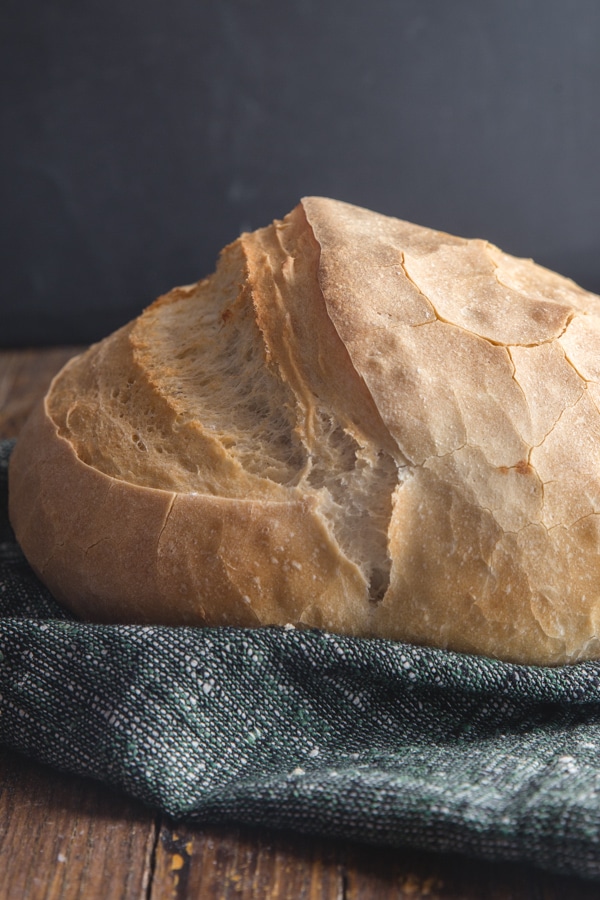
Serve it with your favourite stew or soup or why not grab a slice just because. I love to serve a few slices with my Thick Italian Beef Stew or my Beef Stew with Peas.
I remember the days when my mother-in-law would take her baskets of freshly risen dough down to the wood burning oven and make her amazing Bread and Pizza. Those were certainly the days!
But now I love to get my hands (or my mixer) dirty with flour and make my own Italian Bread. This is the traditional way, with a Biga to start.
The taste is amazing and yes even the Italian was impressed!
How to make Homemade Bread
- To make the Biga – In a large bowl add the water and yeast, let sit five minutes then stir to combine.
- Add the flour and stir just until the flour has absorbed all the water. Do not form a dough.
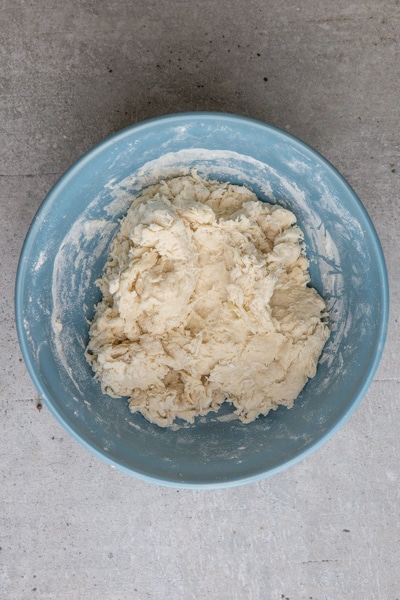
- Cover the bowl with a clean tea towel, place in a warm draft free area and let rise 18-20 hours.
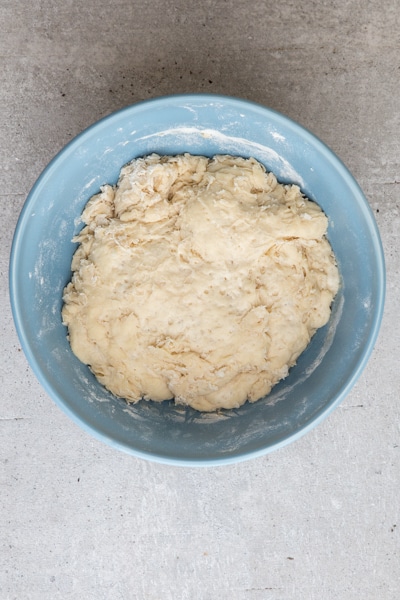
- Once the time as passed, in the bowl of the stand up mixer add the Biga and add part of the water, combine with a spatula.
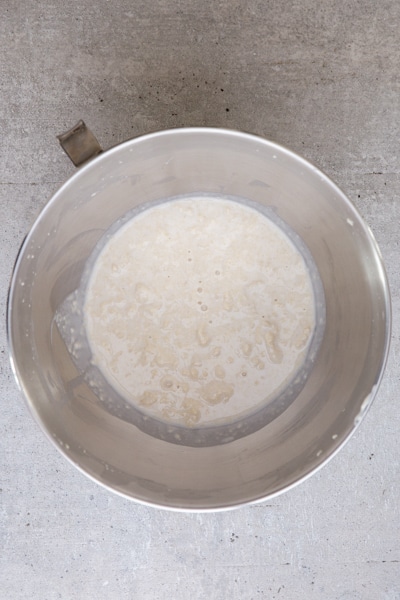
- Add the flour, yeast, salt and the remaining water.
- Start to knead the dough for about four minutes or until the dough starts to pull away from the sides of the bowl.
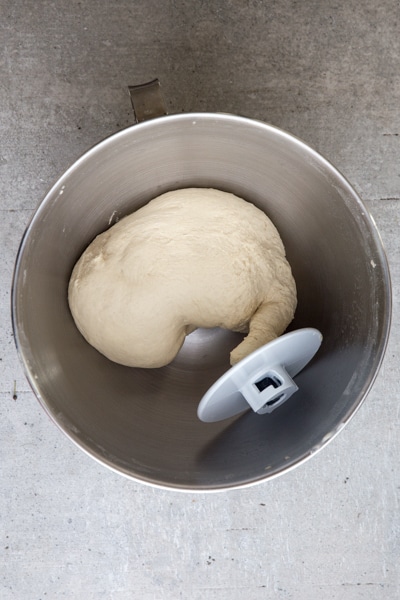
- Move the dough to a lightly floured flat surface and knead to form a smooth dough ball.

- Place the dough in a lightly oiled bowl, cover with a towel and let rise two hours.
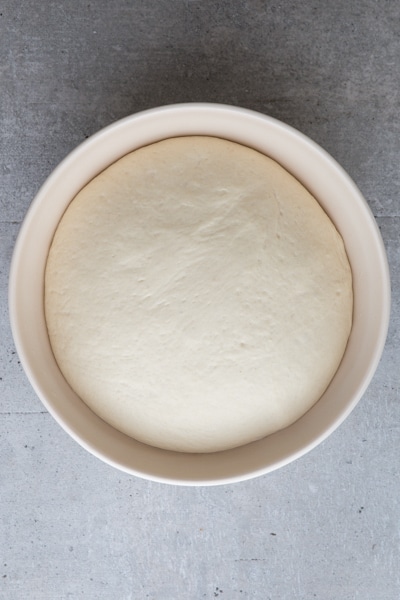
- Form the dough into a round or long loaf or even small buns.
- Place on a parchment paper lined cookie sheet.

- Cover and let rise for two hours.
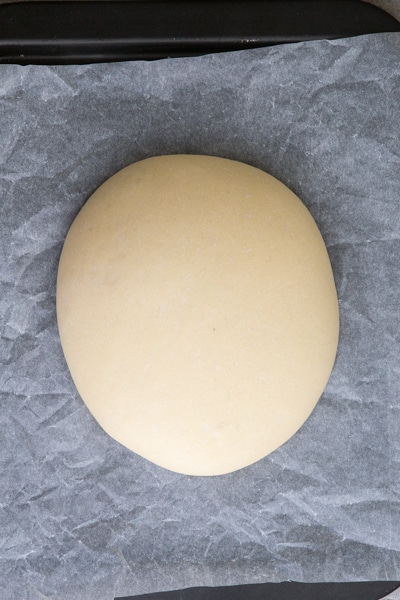
- Place a pan of water on the bottom of the oven.
- Make a score in the bread and bake for about 20-25 minutes.
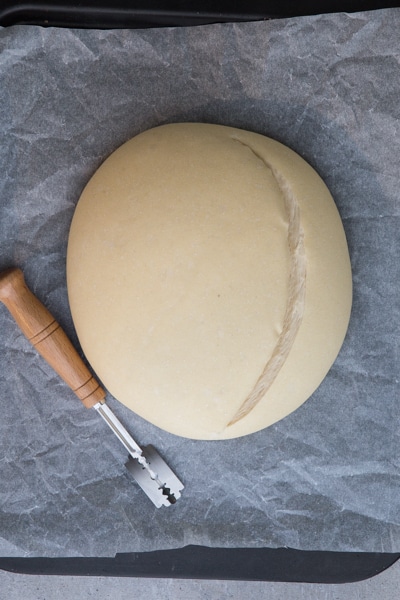
- Remove from the oven and immediately place the loaf on a wire rack to cool. This keeps the bottom from becoming soggy.

What is a Biga?
You may think that a Poolish and a Biga are the same, but the main difference is that a Poolish is a liquid dough and a Biga is a solid dough.
A Biga is a type of rise used in Italian baking. Many popular Italian breads, including a ciabatta and Pandoro, are made using a Biga.
The addition of a Biga is said to add more flavour to the finished product and is also used in breads that need a light, open texture with holes.
Is the yeast active?
The yeast you are using could be old or dead, to tell if the yeast is still active, in a small bowl add a 1/2 cup of water, sprinkle 1 1/2 teaspoons of yeast and a pinch of sugar over the top, stir it up, then let it stand for about 5 minutes.
If the yeast is still active, it will dissolve completely into the water and the liquid will start bubbling.
Make sure your water isn’t too hot or too cold. Too hot and you will kill the yeast, too cold and it will take a long time for the dough to rise. The perfect temperature is 100-110F.
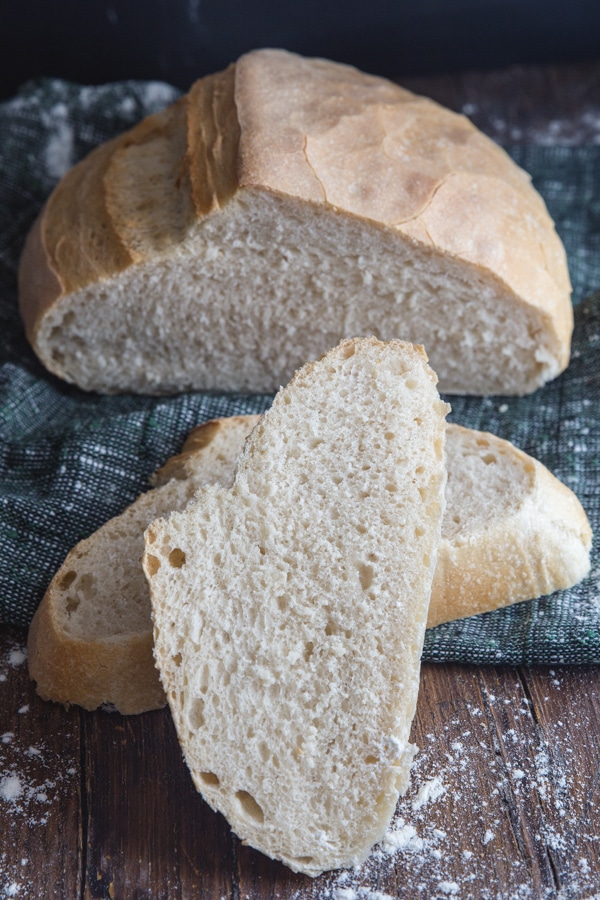
Why do you need to place a pan of water in the oven?
The water in the pan will create steam which helps keep the crust soft. It also lets the bread to continue expanding freely. The steam that settles on the exterior of the bread also helps to dissolve the sugars in the dough.
Bread Flour or all purpose?
I personally use all purpose but if you prefer bread flour works just as well, some people swear by it. It will give your dough a chewier and denser bread.
How to score it
I love the look of a beautifully scored fresh loaf of bread. I discovered an interesting video on the different ways to score bread, you might want to check out the Foodgeek if you need an idea.
How to store the bread
Cool the bread completely, then store it in a plastic airtight bag, storage container, wrap in foil or the Italian way and, place the loaf in a paper bag then place it in a plastic bag and close tightly. It can be kept at room temperature for about two to three days.
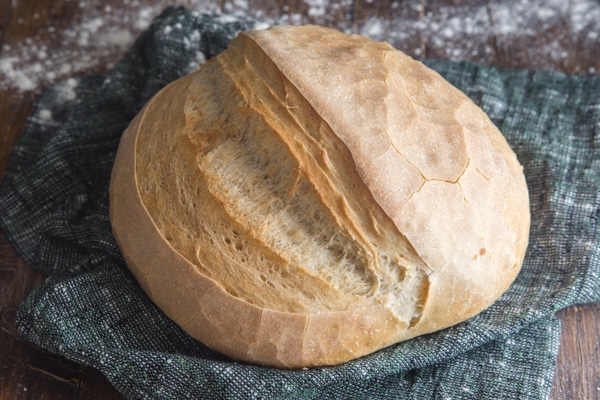
Can you freeze it?
Yes you can freeze it, let the loaf cool completely, then you can either slice it or leave it whole. Be sure to wrap tightly with foil or freezer safe wrap and then place it in a freezer safe bag or container.
Properly stored, it will last for about 3 months.
Different types of Italian Bread
Apparently there are over 250 different types of bread in Italy that are actually made today. I certainly haven’t tried even close to that many, but a few of are favourites are a Ciabatta, Genzano, Lariano and the Italian can never pass up a Cazzottini or two.
More Delicious Bread Recipes
- Fast & Easy No-Knead Bread
- Easy Bannock Bread
- Traditional Italian Focaccia Bread
- Italian Ricotta Parmesan Bread
Probably the most famous saying in Italian referring to bread is “fare la scarpetta” which means “make the little shoe,” it refers to a small piece of bread used to mop up the last of the sauce on your plate. So remember to leave some sauce next time.
So if you are ready and have the time why not make a loaf of Homemade Italian Bread? Let me know how you like it. Enjoy!
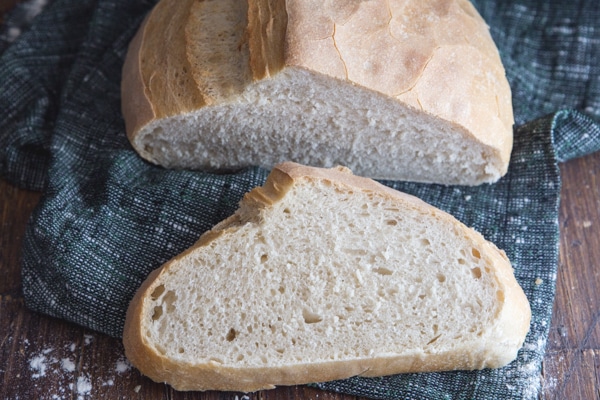
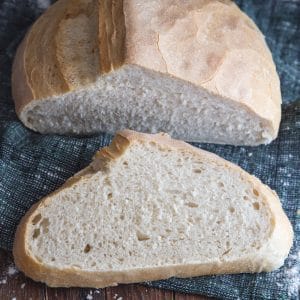
Homemade Italian Bread
Ingredients
FOR THE BIGA
- ½ cup water (lukewarm)*
- ¾ teaspoon active dry yeast
- 2 cups all purpose flour
FOR THE DOUGH
- ¾ cup + 1 tablespoon water (lukewarm)* divided (200 grams total, if you want to double the recipe double this amount)
- 2 cups all purpose flour
- ½ teaspoon active dry yeast
- 1¾ teaspoons salt
*lukewarm water temperature should be between 100-110F (38-43C)
Instructions
FOR THE BIGA
- To make the Biga – In a large bowl add the water and yeast, let sit five minutes the stir to combine.Add the flour and stir just until the flour has absorbed all the water. Do not form a dough ball.
- Cover the bowl with a clean tea towel, place in a warm draft free area and let rise 18-20 hours.
- Once the time as passed, in the bowl of the stand up mixer add the Biga and ¼ cup + 3 1 /2 tablespoons (112 grams) water, combine with a spatula.
- Add the flour, yeast, salt and the remaining water (¼ cup + 1 tablespoon / 74 grams). Start to knead the dough for about four minutes or until the dough starts to pull away from the sides of the bowl.
- Move the dough to a lightly floured flat surface and knead to form a smooth dough ball.
- Place the dough in a lightly oiled bowl, cover with tea towel and let rise for two hours.
- Form the dough into a round or long loaf or even small buns whichever you prefer. Place on a parchment paper lined cookie sheet. Cover again and let rise for two hours.
- Pre-heat oven to 425F (220C). Place a pan of water on the bottom of the oven.
- Make a score in the bread and bake for about 20-25 minutes. Remove from the oven and immediately place on a wire rack to cool. Enjoy!
This bread is amazing. Absolutely a “no fail” recipe. I have already made it twice and both times it was a success. The dough is a dream to work with and it rises and bakes up beautifully. Thank you so much for posting this recipe!
Thanks so much Laura glad you like it. Have a great weekend.
Can you use the “proofing” cycle on a oven for the rising of the Biga and the additional rises?
Hi Ness, I have never used a proofing cycle, I think you could. Let me know how it goes. Happy New Year.
I love this recipe and how the crumb is so soft. I want to make it again but I only have instant yeast. Will that work? Also, can I use Italian type 00 flour? Thanks!
Hi Gigi, for this recipe I really wouldn’t substitute the yeast because you need to make a biga. And 00 flour isn’t strong enough, you will need a strong all purpose or bread flour with at least 12% protein to make the bread. Sorry.
Why specify AP flour if the bread needs at least 12% protein? Even KAF AP is only 11.7% and most other brands are less.
Hi Scruffy, 11.7 would be fine and even bread flour if you are making bread. Hope that helps.
could I use bread flour
Hi Ron, yes you can. I hope you like it.
I made this the other day. We love it. Told a friend that we could make a meal of just this bread.
Definitely a keeper recipe Been looking for a good Italian bread recipe, now I have it.
Thank you
Hi Chuck, thanks so much, so glad you enjoyed it. I totally understand between bread and pasta I am good to go. 🙂
I use stone ground bread flour for this recipe. Unfortunately the biga seems very dry – the water is absorbed by only about 80% of the flour, and after the 18 hours ii is lumpy, the lumps being very hard. I find it extremely difficult to then incorporate the extra water, flour etc to make the dough. Should I add extra water for the biga? And how much should I add if this will work? Thanks, Nicole Gerber.
Hi Nicole, I just made this again the other day and the biga is on the drier side although not as dry as you say, so I would add a bit more water and see how that goes. Let me know.
This bread is so good, after decades of bread making I will be ditching my previous favourite recipe and making this one regularly. Using the Biga starter gives so much flavour and the bread has a lovely chewy crust, a real treat.
Hi Dawn, thanks so much, so glad you enjoyed it. Take care.
Looking for advice, I tried the biga twice, following the recipe and directions exactly, and had trouble. The biga never rose, just remained flat and dried out. I was making another yeast bread on the same days, so know that my yeast was OK. Any advice of what I might have done wrong?
Hi Mary sorry it took so long to answer but I was remaking it again, so the biga does not grow that much, but the 2nd rise (bread dough) will so it will work. Hope that helps.
What is the final texture of the Biga? I left covered of night and it has hard spots? Is that right and will it liquify again when you use it?
Hi AFD yes that is right, mine had a few hard spots also. Mixing it with the ingredients will soften it up. Let me know how it goes.
The recipe looks fantastic but I can’t find yeast ANYWHERE!!! Help! I need this bread in our home!
Do I add a pinch of sugar to the Biga?
Hi Jenn, no it’s not necessary. I hope you enjoy it.
Thank You for this recipe!
In Poland bread is essential ingredient of breakfasts.
My family love this bread.
I prepare it very often. Is the best one!
Hi Daria, thanks glad you like it.
I keep my flour in the freezer all the time. Should the flour be at room temperature or can I use it straight out of the freezer? Will it affect the rising process.
Thanks for any advice you can offer.
Hi Jim, yes I would definitely bring it to room temperature, probably for any baking recipe. Let me know how it goes.
I was going to try making the bread this week. Thanks for the recipe.
Could I add raw garlic to the dough for a garlic taste in the bread?
Hi Pat, sure that would be fine, I would probably add it after the first rise. Let me know how it turns out.
This looks wonderful! Has anyone tried this recipe using gluten free flour?